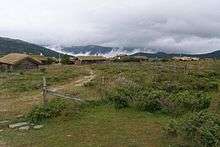Høvringen

Høvringen is located 1000 meters above the sea level in the northern end of the valley Gudbrandsdalen in the municipality of Sel. Høvringen is the main entrance to Rondane National Park, the very first national park in Norway.
History
Originally, Høvringen was a community of summer mountain pastures ("seter" in Norwegian) used by farmers from the villages further down. The first tourists came to Høvringen as early as the 1880s, and even though it has now developed into a modern tourist resort, the animal life is still rich and high standards and good service are combined with preservation of the culture and tradition of the old "seter" farms.
Tourism
The culture and traditions of the old mountain pasture community are still well preserved and today Høvringen has about 1000 guest beds including everything from simple self-catering cabins and a mountain school camp to several mountain lodges and hotels. In addition over 200 privately owned cottages are built in the area.
Høvringen and its surrounding areas has 120 km prepared cross country tracks and 50 km marked tracks within Rondane Nasjonalpark. The marked summer hiking trails expands for more than 150 km both within and outside Rondane National Park.
Culture
Høvringen and Rondane have left their mark in Norwegian cultural history. On his journey through the valley of Gudbrandsdalen, Peter Christen Asbjørnsen, well known for his compilations of old Norwegian legends and fairy-tales, stayed in Høvringen in 1842. His stay formed the basis for the story of a local legend, Peer Gynt, who came upon trolls and terrifying monsters in Rondane. Asbjørnsen's fairy-tale Reindeer hunt at Rondane 20 years later created the basis for Henrik Ibsen's drama, Peer Gynt.
In The Bridal Wreath, the first part of Sigrid Undset's trilogy Kristin Lavransdatter, the young protagonist, Kristin, is allowed to accompany her father up into the mountains. Here, Høvringen is depicted with an atmosphere of great legend and superstition. It is no exaggeration to say that Kristin was very impressed by her first sight of Høvringen and the Rondane mountain range: "Kristin gazed with great eyes- never before had she dreamed that the world was so big and wide. Forest-shagged ranges lay below her on all sides; the valley was but a cleft betwixt the huge fells, and the side-glens still lesser clefts; there were many such, yet was there little of dale and much of fell. All around grey peaks, flaming with golden lichen, rose above the sea of forest, and far off, on the very brink of heaven, stood blue crests flashing here and there with snow, and melting, before their eyes, into the grey-blue and pure white summer clouds. But north-eastwards, nearer by- just beyond the sæter woods- lay a cluster of mighty slate-coloured domes with streaks of new-fallen snow down their slopes."
Writer Aasmund Olavsson Vinje gave Rondane a central position in his poetic travelogue Ferdaminne. His poem Ved Rondane was later set to music by Edvard Grieg, who also wrote music for Ibsen's play. Painters Erik Werenskiold, Hans Gude and not least Harald Solberg have all found motives in Rondane for their works. Solberg's A winter's night in Rondane has been voted the national painting of Norway.
External links
Official Tourist Information
Well known lodges at Høvringen:
- Den Norske Fjellskolen Rondeheim
- Øigardseter Fjellstue
- Smuksjøseter Fjellstue
- Rondane Haukliseter Fjellhotell
- Putten Seter